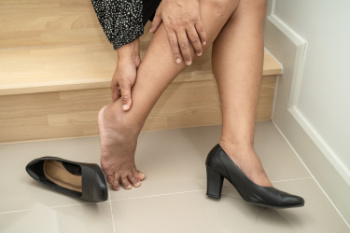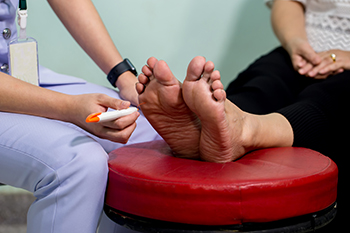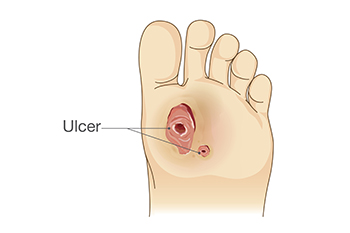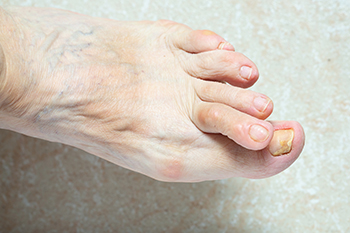Connect With Us
Blog
Items filtered by date: January 2024
Common Reasons for Foot Pain

Foot pain can be attributed to several causes that often affect individuals irrespective of age or lifestyle. Plantar fasciitis, a condition characterized by inflammation of the tissue connecting the heel bone to the toes, can lead to stabbing pain upon standing. Another common offender is bunions, the bony protrusions that form at the base of the big toe, causing discomfort and altering foot structure. Arthritis, an inflammatory joint condition, can afflict the feet, resulting in persistent pain and reduced mobility. Strained or overworked muscles, often a consequence of prolonged standing or intense physical activity, can contribute to general foot soreness. Wearing ill-fitting footwear, such as tight shoes or high heels, can also be a frequent source of pain. Understanding these common triggers for foot discomfort is essential for effective prevention and management. If you have foot pain for any reason, it is strongly suggested that you schedule an appointment with a podiatrist who can determine the cause and offer effective treatment methods.
Foot Pain
Foot pain can be extremely painful and debilitating. If you have a foot pain, consult with one of our podiatrists from Kokomo Foot & Ankle Center. Our doctors will assess your condition and provide you with quality foot and ankle treatment.
Causes
Foot pain is a very broad condition that could be caused by one or more ailments. The most common include:
- Bunions
- Hammertoes
- Plantar Fasciitis
- Bone Spurs
- Corns
- Tarsal Tunnel Syndrome
- Ingrown Toenails
- Arthritis (such as Gout, Rheumatoid, and Osteoarthritis)
- Flat Feet
- Injury (from stress fractures, broken toe, foot, ankle, Achilles tendon ruptures, and sprains)
- And more
Diagnosis
To figure out the cause of foot pain, podiatrists utilize several different methods. This can range from simple visual inspections and sensation tests to X-rays and MRI scans. Prior medical history, family medical history, and any recent physical traumatic events will all be taken into consideration for a proper diagnosis.
Treatment
Treatment depends upon the cause of the foot pain. Whether it is resting, staying off the foot, or having surgery; podiatrists have a number of treatment options available for foot pain.
If you have any questions, please feel free to contact our office located in Contact Us . We offer the newest diagnostic and treatment technologies for all your foot care needs.
Plantar Warts Can Be Treated!
Understanding Neuropathy Symptoms in the Feet

Neuropathy, a condition that affects the peripheral nerves, can result in various symptoms, and often has a pronounced impact on the feet. Individuals experiencing neuropathy may encounter sensations of tingling, burning, or numbness in their lower extremities. These discomforting sensations can progress to sharp, stabbing pain, hindering mobility and diminishing overall quality of life. Loss of coordination and balance may also occur, elevating the risk of falls and injuries. Changes in skin texture and temperature, coupled with muscle weakness, are additional indicators of neuropathy. As the condition advances, individuals may develop foot deformities. Seeking medical attention when these signs arise is imperative to identify the underlying causes, which may include diabetes, infections, or autoimmune disorders. If you are experiencing symptoms of neuropathy in your feet, it is suggested that you visit a podiatrist who can accurately diagnose this condition and offer treatment methods.
Neuropathy
Neuropathy can be a potentially serious condition, especially if it is left undiagnosed. If you have any concerns that you may be experiencing nerve loss in your feet, consult with one of our podiatrists from Kokomo Foot & Ankle Center. Our doctors will assess your condition and provide you with quality foot and ankle treatment for neuropathy.
What Is Neuropathy?
Neuropathy is a condition that leads to damage to the nerves in the body. Peripheral neuropathy, or neuropathy that affects your peripheral nervous system, usually occurs in the feet. Neuropathy can be triggered by a number of different causes. Such causes include diabetes, infections, cancers, disorders, and toxic substances.
Symptoms of Neuropathy Include:
- Numbness
- Sensation loss
- Prickling and tingling sensations
- Throbbing, freezing, burning pains
- Muscle weakness
Those with diabetes are at serious risk due to being unable to feel an ulcer on their feet. Diabetics usually also suffer from poor blood circulation. This can lead to the wound not healing, infections occurring, and the limb may have to be amputated.
Treatment
To treat neuropathy in the foot, podiatrists will first diagnose the cause of the neuropathy. Figuring out the underlying cause of the neuropathy will allow the podiatrist to prescribe the best treatment, whether it be caused by diabetes, toxic substance exposure, infection, etc. If the nerve has not died, then it’s possible that sensation may be able to return to the foot.
Pain medication may be issued for pain. Electrical nerve stimulation can be used to stimulate nerves. If the neuropathy is caused from pressure on the nerves, then surgery may be necessary.
If you have any questions, please feel free to contact our office located in Contact Us . We offer the newest diagnostic and treatment technologies for all your foot care needs.
Treatment for Diabetic Foot Ulcers

Diabetic foot ulcers pose a significant risk for individuals with diabetes, due to poor skin circulation and reduced foot sensation. Preventative measures, such as regular foot examinations and maintaining optimal diabetic control, are essential in averting these complications. Once diabetic foot ulcers develop, effective treatment becomes paramount. Typically, a protective dressing is applied, and a podiatrist plays a pivotal role in regular examination, cleaning, and redressing of the ulcer. Podiatrists may also remove hard skin hindering the healing process and prescribe padding or recommend specialized shoes to alleviate pressure. In cases of infection, oral antibiotics can be prescribed, and, if necessary, intravenous antibiotics can be administered. Surgical procedures, such as draining pus or removing dead tissue, may be required in severe infections. While many foot ulcers respond well to treatment, some may lead to severe infections or other complications. Managing diabetic foot ulcers is a long-term problem, emphasizing early intervention and meticulous care for improved outcomes and overall foot health. For help in managing diabetic foot ulcers, it is suggested that you schedule regular appointments with a podiatrist.
Diabetic foot care is important in preventing foot ailments such as ulcers. If you are suffering from diabetes or have any other concerns about your feet, contact one of our podiatrists from Kokomo Foot & Ankle Center. Our doctors can provide the care you need to keep you pain-free and on your feet.
Diabetic Foot Care
Diabetes affects millions of people every year. The condition can damage blood vessels in many parts of the body, especially the feet. Because of this, taking care of your feet is essential if you have diabetes, and having a podiatrist help monitor your foot health is highly recommended.
The Importance of Caring for Your Feet
- Routinely inspect your feet for bruises or sores.
- Wear socks that fit your feet comfortably.
- Wear comfortable shoes that provide adequate support.
Patients with diabetes should have their doctor monitor their blood levels, as blood sugar levels play such a huge role in diabetic care. Monitoring these levels on a regular basis is highly advised.
It is always best to inform your healthcare professional of any concerns you may have regarding your feet, especially for diabetic patients. Early treatment and routine foot examinations are keys to maintaining proper health, especially because severe complications can arise if proper treatment is not applied.
If you have any questions please feel free to contact our office located in Contact Us . We offer the newest diagnostic and treatment technologies for all your foot and ankle needs.
Causes of Hammertoe and Vulnerable Individuals

Hammertoe, a podiatric condition characterized by an abnormal bending of the toes, primarily affects the second, third, or fourth toe joints, causing them to resemble a hammer. This deformity is often a result of an imbalance in the muscles, tendons, or ligaments that hold the toe straight. One common cause is wearing shoes that force the toes into a bent position, hindering the natural alignment. Individuals with a second toe longer than the big toe, flat feet, or a family history of hammertoe are more prone to developing this condition. Women, particularly those who frequently wear high heels or narrow shoes, face an increased risk. Additionally, individuals with arthritis or conditions causing muscle and ligament imbalances may find themselves susceptible to hammertoe. If you have developed hammertoe, it is strongly suggested that you are under the care of a podiatrist who can offer treatment options for this condition.
Hammertoe
Hammertoes can be a painful condition to live with. For more information, contact one of our podiatrists from Kokomo Foot & Ankle Center. Our doctors will answer any of your foot- and ankle-related questions.
Hammertoe is a foot deformity that affects the joints of the second, third, fourth, or fifth toes of your feet. It is a painful foot condition in which these toes curl and arch up, which can often lead to pain when wearing footwear.
Symptoms
- Pain in the affected toes
- Development of corns or calluses due to friction
- Inflammation
- Redness
- Contracture of the toes
Causes
Genetics – People who are genetically predisposed to hammertoe are often more susceptible
Arthritis – Because arthritis affects the joints in your toes, further deformities stemming from arthritis can occur
Trauma – Direct trauma to the toes could potentially lead to hammertoe
Ill-fitting shoes – Undue pressure on the front of the toes from ill-fitting shoes can potentially lead to the development of hammertoe
Treatment
Orthotics – Custom made inserts can be used to help relieve pressure placed on the toes and therefore relieve some of the pain associated with it
Medications – Oral medications such as anti-inflammatories or NSAIDs could be used to treat the pain and inflammation hammertoes causes. Injections of corticosteroids are also sometimes used
Surgery – In more severe cases where the hammertoes have become more rigid, foot surgery is a potential option
If you have any questions please contact our office located in Contact Us . We offer the newest diagnostic and treatment technologies for all your foot and ankle needs.
Reasons to See a Podiatrist

Podiatrists are specialized healthcare professionals who focus on the diagnosis, treatment, and prevention of foot and ankle disorders. There are various compelling reasons to schedule a visit to a podiatrist. First, persistent foot or ankle pain should not be ignored, as it can be an indicator of an underlying issue. Podiatrists are experts in identifying and addressing the source of your discomfort. They can diagnose conditions such as plantar fasciitis, bunions, or heel spurs, and develop personalized treatment plans. If you are experiencing mobility issues, a podiatrist can help. They can provide custom orthotics or recommend appropriate footwear to improve your gait and balance. Diabetes can take a toll on the feet, leading to complications like neuropathy and ulcers. Regular check-ups with a podiatrist are essential for early detection and preventative care. In short, consulting a podiatrist is beneficial for anyone seeking to maintain their overall foot health, in addition to alleviating foot pain. It is suggested that you visit a podiatrist if you are interested in learning more about the field of podiatry.
If you are dealing with pain in your feet and ankles, you may want to seek help from a podiatrist. Feel free to contact one of our podiatrists from Kokomo Foot & Ankle Center. Our doctors can provide the care you need to keep you pain-free and on your feet.
What Is a Podiatrist?
A podiatrist is a doctor of podiatric medicine who diagnoses and treats conditions of the foot, ankle, and related structures of the leg. Your podiatrist may specialize in a certain field such as sports medicine, wound care, pediatrics, and diabetic care. Podiatrists have the ability to become board certified through training, clinical experience, and then taking an exam.
What Do Podiatrists Do?
On a daily basis, a podiatrist may perform the following activities:
- Diagnose foot ailments such as ulcers, tumors, fractures, etc.
- Use innovative methods to treat conditions
- Use corrective orthotics, casts, and strappings to correct deformities
- Correct walking patterns and balance
- Provide individual consultations to patients
It is very important that you take care of your feet. It’s easy to take having healthy feet for granted, however foot problems tend to be among the most common health conditions. Podiatrists can help diagnose and treat a variety of feet related conditions, so it is crucial that you visit one if you need assistance.
If you have any questions please feel free to contact our office located in Contact Us . We offer the newest diagnostic and treatment technologies for all your foot and ankle needs.

